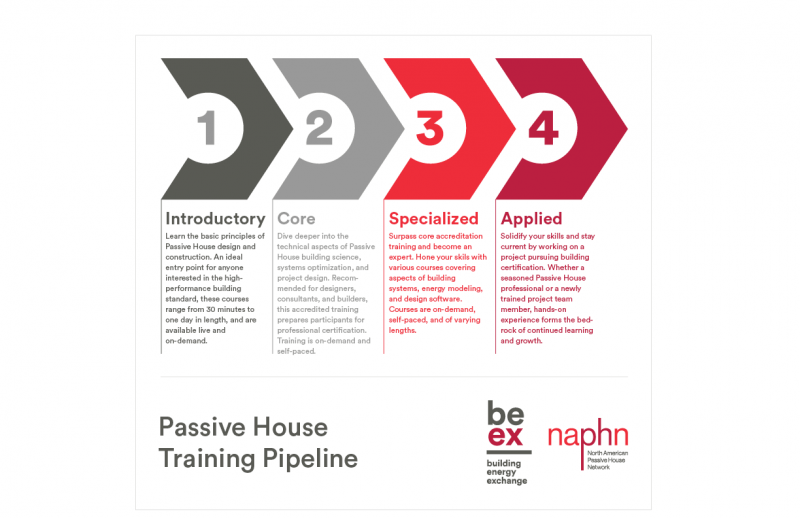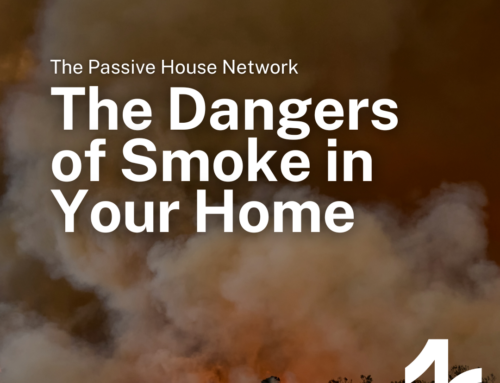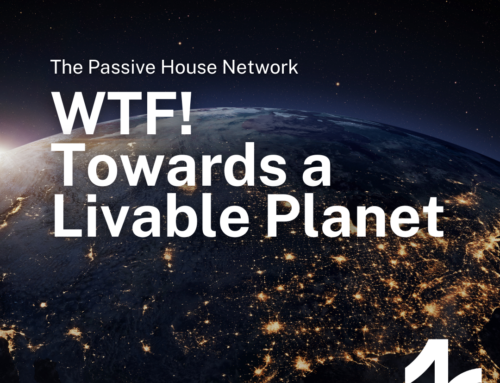NAPHN & BE-Ex Announce the Launch of New Online Passive House Education Pathway
The new coordinated online education offerings provide a clear pathway for building professionals and a wide range of industry stakeholders to upskill in support of New York State’s carbon reduction commitments.

New York, NY June 30, 2021 – North American Passive House Network (NAPHN) and Building Energy Exchange (BE-Ex) announce the launch of a new, coordinated on-demand Passive House training pathway for all industry stakeholders. This unique professional development pipeline provides short, introductory courses on critical Passive House principles and culminates in the Certified Passive House Designer (CPHD) training for building professionals across New York State and the US.
NAPHN and BE-Ex have created a high-performance building training pipeline of courses that range from introductory to advanced, and are available on their respective on-demand learning platforms. BE-Ex Ed is available here: https://learn.be-exchange.org/, and NAPHN’s platform is here through registration: https://passivehousenetwork.org/education/on-demand-training/. The training platforms were made possible, in part, by the financial support of the New York State Energy Research and Development Authority (NYSERDA).
BE-Ex offers a one-hour introductory Passive House Primer and a suite of six technical modules that demystify the basic principles of Passive House design and construction, explain their benefits in the real world, and connect them to the broader context of building energy codes, climate policy, and real estate trends. Later this year, BE-Ex will also unveil a Passive House Primer for Construction Trades, providing a much-needed entry point for this critical set of stakeholders. Available live and on-demand, these training modules are suited for not only working practitioners like architects and engineers but also everyone from the general public to building owners, real estate agents, and builders.
These shorter modules introduce Passive House to the widest possible audience while NAPHN offers a more in-depth look at the science of Passive House through either an on-demand or a live online version of their landmark CPHD course. The CPHD is the premier training program for Passive House building professionals working on residential, institutional, and commercial projects. Based on more than 25 years of global technical leadership from the Passive House Institute (PHI), the continuously updated CPHD has been the cornerstone of professional education of Passive House principles for years. Making this seminal course available on-demand has transformative implications for the industry. Additionally, NAPHN provides in-depth specialized technical modules on a variety of critical subjects – advanced courses that prepare participants to design high-performance, energy-efficient buildings that meet the needs of the future through globally recognized Passive House principles.
Meeting the aggressive carbon reduction commitments of New York State will require dramatic and unprecedented improvements in the design, construction, retrofitting, and operations of buildings of all types. Designers, engineers, builders, owners, and operators of buildings must all become comprehensively knowledgeable about the most effective principles, concepts, and strategies of low-energy and high-performance buildings if we are to deliver the zero-carbon future.
Education on Passive House principles has been uniquely successful in changing the way building industry professionals understand the energy consequences of design and construction decisions—it is often said that once one understands the fundamentals of the Passive House standard, one can never look at a building the same way again.
A core goal of BE-Ex and NAPHN’s new Passive House education pathway and on-demand training platforms is to rapidly increase the uptake of high-performance building training across New York State among architects, mechanical engineers, sustainability, and energy consultants, structural engineers, estimators, energy modelers, and tradespeople. Doing so will provide much-needed upskilling opportunities for members of building design teams seeking to deliver high-performance low-emission buildings for both new construction and retrofit projects in commercial and residential markets.
NAPHN has been supported in the development of the on-demand CPHD course by the Passive House Academy (PHA) of Jericho NY, and Wicklow Ireland. PHA is among the premier Passive House training and consulting organizations around the world, with an extensive history of delivering and developing CPHD courses.
“We are excited to launch this coordinated on-demand training pathway with BE-Ex, as it will allow us to meet the challenge of scaling capacity and impact in support of New York State’s carbon reduction goals,” said NAPHN Executive Director, Ken Levenson. “The new platform will support CPHD training across New York and across the US as well.”
“BE-Ex is pleased to bring our proven expertise in creating and delivering educational resources to our collaboration with NAPHN,” said Richard Yancey, Executive Director of the Building Energy Exchange. “Our courses—ranging from introductory to advanced—offer much-needed entry points for professionals of all backgrounds to enhance their knowledge and skills in the rapidly growing high-performance building market.”
Doreen M. Harris, President and CEO of NYSERDA said, “As we transition to a clean energy economy and work toward decarbonizing our existing and future building stock, it is critical to ensure that our workforce has the skills and training needed to participate in and support this transformation. This online education pathway provides easily accessed courses for a wide spectrum of stakeholders – from skilled tradespeople to engineers and architects – to upskill or learn entirely new Passive House principles and be well-prepared to step into a good-paying clean energy job in one of the State’s fastest-growing sectors while helping us reach our climate goals.”
NYSERDA supported the project with nearly $250,000 in funding through its Workforce Development and Training Program, which will enable approximately 6,000 individuals to receive training.
With these new courses, students can choose which level works for their training needs and can take a flexible self-paced approach to learning. The on-demand Passive House Primer and follow-on technical modules range from 30 minutes to one hour in length. The CPHD training takes place over 10-12 weeks with two live-online webinars and careful examination preparation. After successful completion of the examination, the Certified Passive House Designer certification serves as a clear indicator of technical knowledge and industry leadership. Student profiles include architects, MEP and structural engineers, facade, energy and sustainability consultants, contractors, developers, policymakers, regulators, and more.
# # #
About NAPHN:
The North American Passive House Network (NAPHN) is an independent national non-profit educational organization affiliated with the International Passive House Association (iPHA) and the Passive House Institute (PHI), located in Darmstadt, Germany.
NAPHN has chapters based in New Jersey (www.njpassivehouse.com), Washington DC (www.passivehousenetwork.org), the Rocky Mountain Region (www.phrockymountains.com), Minnesota (www.passivehouseminnesota.org) and Western Pennsylvania (www.passivehousewpa.com).
NAPHN supports the widespread adoption of the international Passive House design and construction standards, building science principles and protocols, as a critical response to our climate crisis – providing unparalleled effectiveness in mitigating climate disruptions and adapting to rapidly changing environmental conditions.
NAPHN is focused on the inflection point between policy and implementation. We partner with leading stakeholders across all building sectors, including governments, professional associations, manufacturers, owners, builders, labor organizations, and educational institutions – to make the transformation complete (passivehousenetwork.org).
About BE-Ex:
The Building Energy Exchange (BE-Ex) is a center of excellence dedicated to reducing the effects of climate change by improving the built environment. BE-Ex accelerates the transition to healthy, comfortable, and energy efficient buildings by serving as a resource and trusted expert to the building industry (be-exchange.org).
BE-Ex’s on-demand learning platform, BE-Ex Ed (learn.be-exchange.org), features video courses on energy efficiency, high-performance design, and policy and codes that impact the building industry. All courses are available for continuing education credit and certificates of completion.
About Passive House:
Passive House is an international building standard and methodology, applicable to buildings of all kinds from office buildings to hospitals, new-build and renovations, that results in a dramatic
drop in operational energy use, and more comfortable and healthy occupants – meant to aggressively mitigate our climate crisis while providing resilient adaptation.
The Passive House Standard was developed by the Passive House Institute (PHI), an independent scientific research organization, located in Darmstadt, Germany, and includes specific requirements for energy use and comfort of occupants. The Passive House Standard is being successfully applied to thousands of buildings and millions of square feet around the world, from Boston to Beijing.
The Passive House methodology starts with reducing cooling, dehumidification and heating loads by focusing, not on gadgets and active technology, but instead on fully integrated durable passive building components, such as proper continuous thermal-bridge-free insulation, continuous airtightness, high-performance windows and doors, and ventilation that includes a high-efficiency heat/energy recovery core, carefully calculated, and all integrated with the entire architectural process of design and construction (http://www.passivehouse.com, http://www.passipedia.org).
View an Introduction to Passive house video: https://youtu.be/G1u5q8IbCak
Not sure what Passive House means? Watch this video: https://youtu.be/fy9nnso306o




